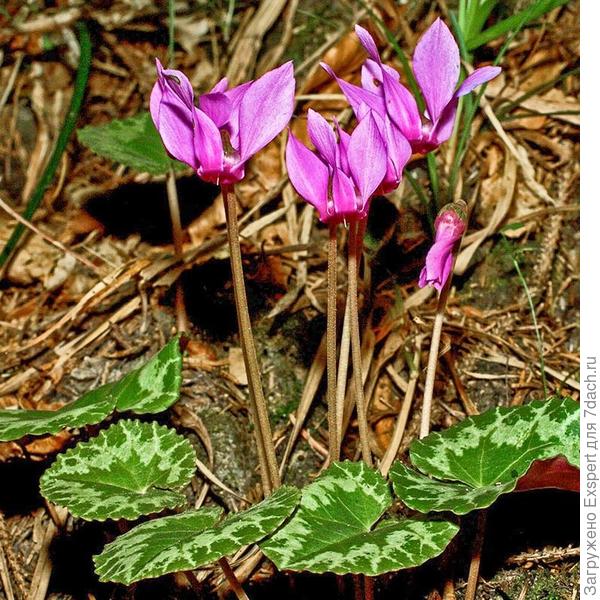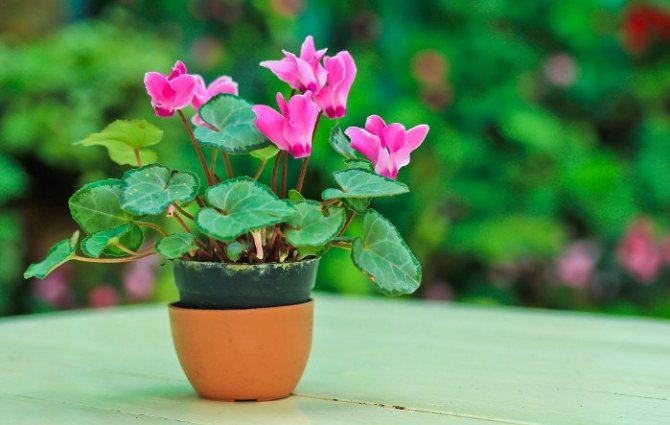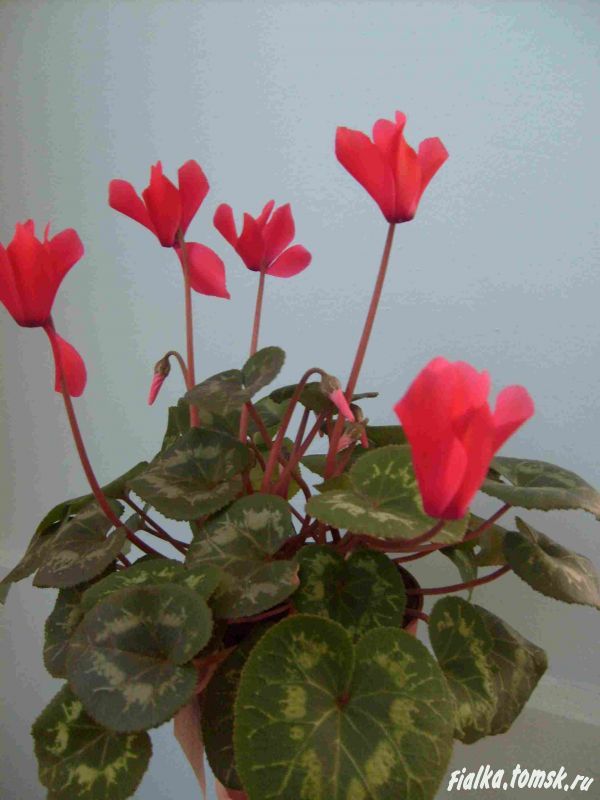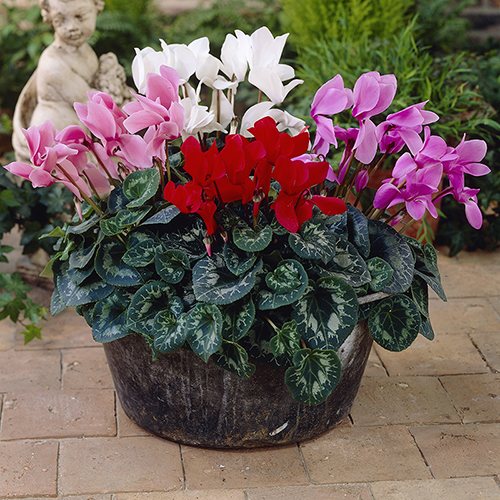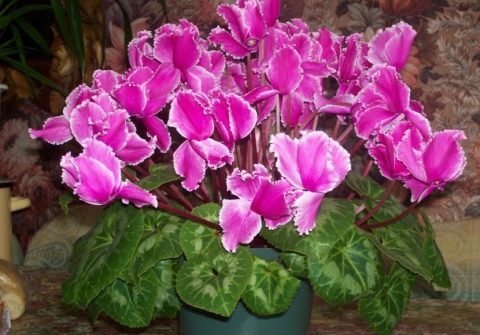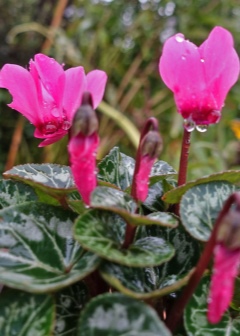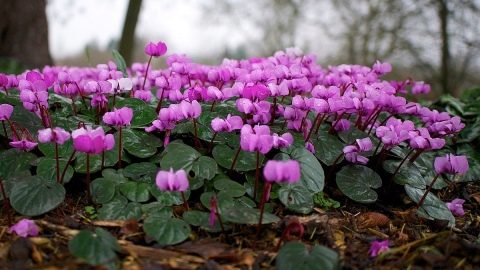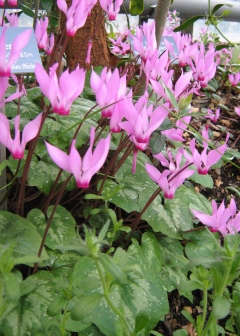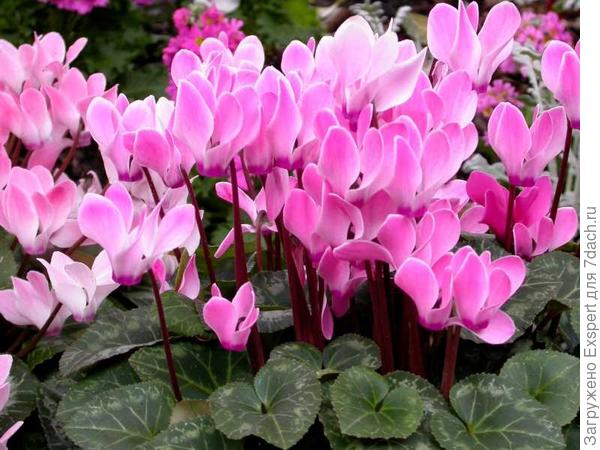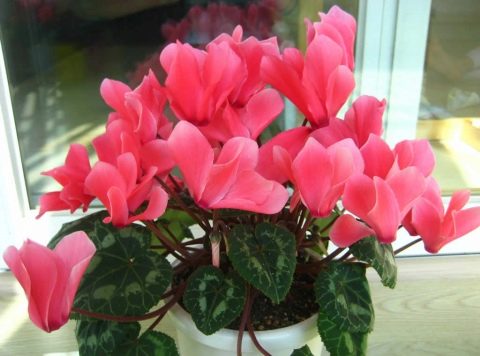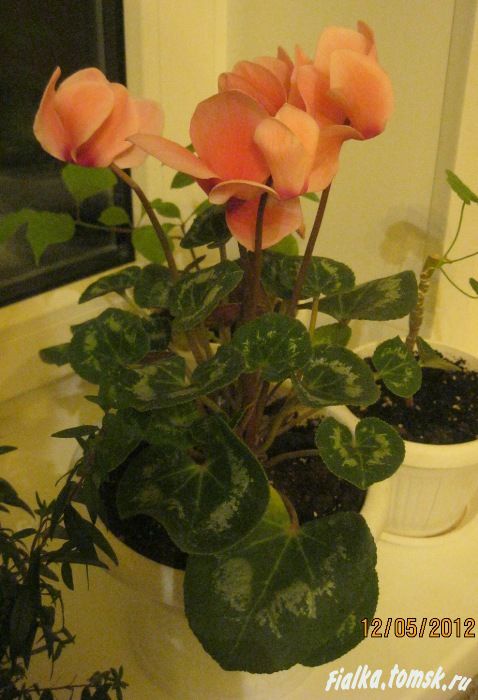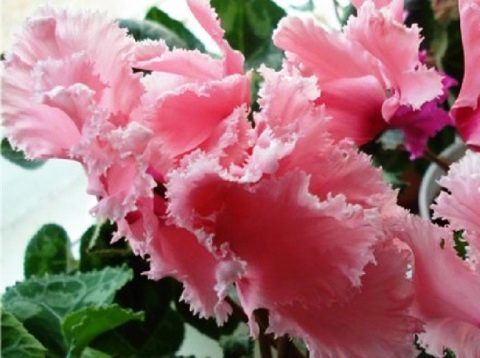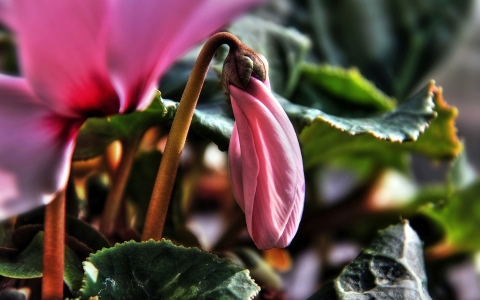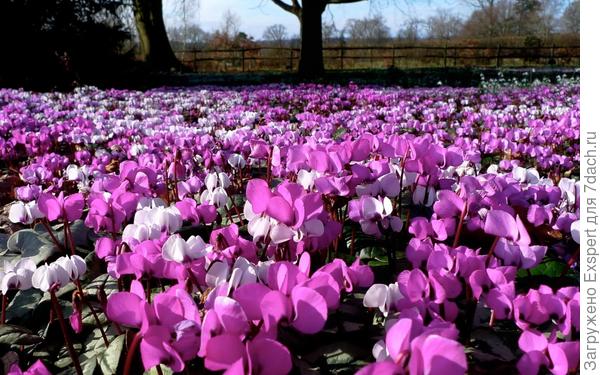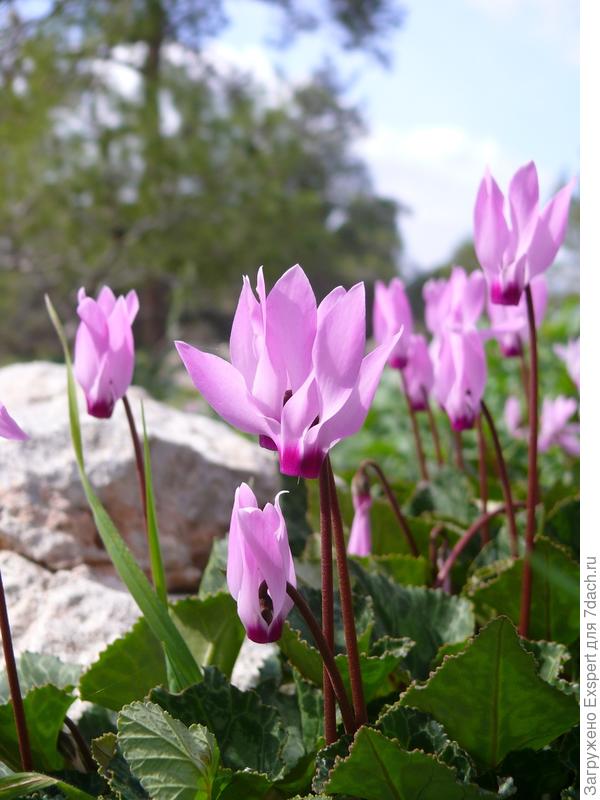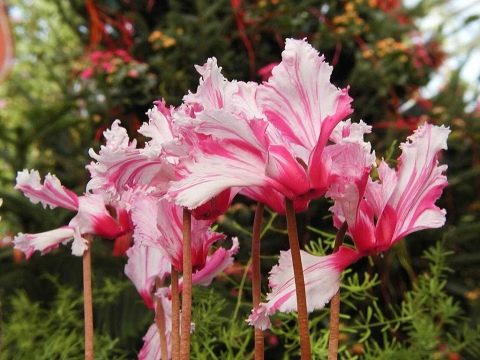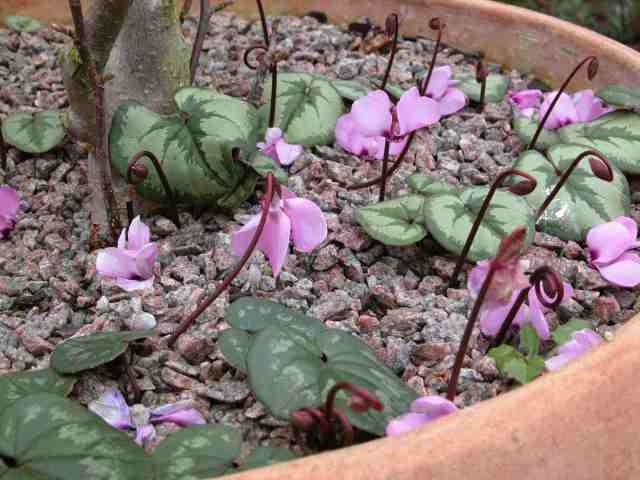Varieties of cyclamen
There are not so many varieties of cyclamen, there are only two of them. The indoor flower is very beautiful and popular among gardeners, since it is not difficult to plant it, and cyclamen is unpretentious in care. But let's take a closer look at the European and Persian varieties. Let's find out what are the differences and similarities between these two species.
European type of cyclamen
The European type of cyclamen, or, as it is also called, "purple", includes several subspecies: purple, ivy and notched.
European cyclamen is a perennial plant with a flat tuber 10 centimeters in diameter. A characteristic feature by which you can recognize the European species of a plant is precisely the tuber flattened on all sides. The leaves of the European species are long and extend from the root. The color of the leaves can be different. But most often there are leaves of a pale green color with silvery blotches. Cyclamen can also be recognized by the leaf plate: it has a heart-shaped shape, and the edges are slightly pointed. You can see a photo of European cyclamen below.
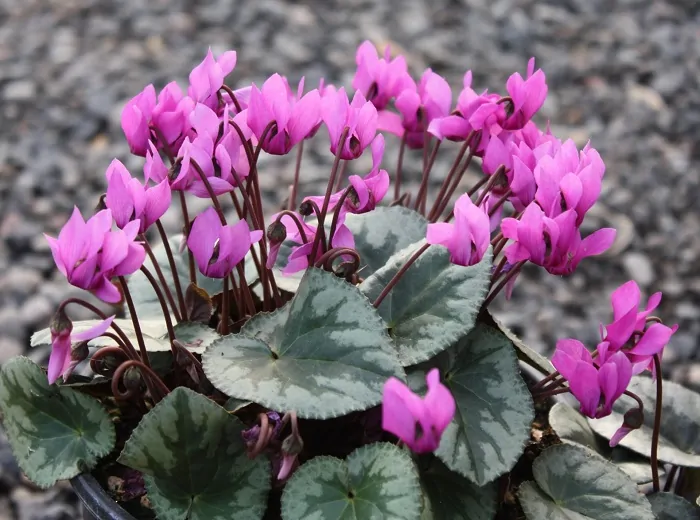
Cyclamen blooms from summer to October, its peduncles are quite long, and the flowers have five oval petals twisted into a spiral. The color scheme can vary from lilac tones to purple.
In addition to the fact that cyclamen is a beautiful flower, it is also useful, as it is a powerful antiseptic, and it can be used to treat viral infections in the body.
Persian view
The Persian type of cyclamen, or "alpine violet", is a perennial herb that reaches a height of 30 centimeters. The tubers are even larger than those of the European - 15 centimeters. Leaves are basal, heart-shaped and variegated in color. Peduncles are the same larger (15-20 centimeters) as in the European species. But the color range of this representative is wider than that of the European one. There are white, pink, scarlet, lilac, violet and lilac shades of flowers. During the flowering period, up to 100 flowers can bloom on one flower. You can see a photo of the Persian cyclamen below.
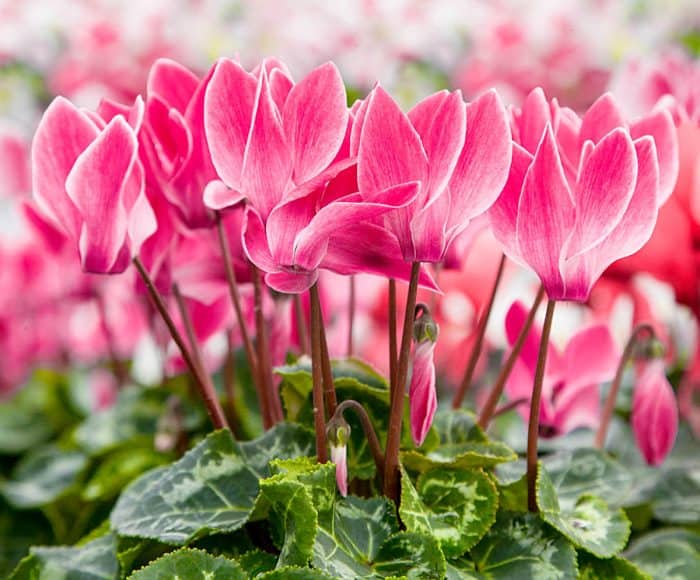
Persian cyclamen blooms in autumn or winter. The duration of flowering depends on the variety and on the care of the flower.
Regardless of the type, the division of a flower is possible in several ways, which we will discuss below. You should carefully read the information, as each method has certain differences.
Cyclamen (alpine violet) care at home
The key to the successful cultivation of cyclamen is the correct choice of place for its placement. The most common cause of plant death is too warm content (on the windowsill above the central heating battery).
Caring for an alpine violet involves placing the plant on the windowsill of eastern or western windows or on an insulated loggia (at a temperature not higher than +18 ° C). It is only necessary to provide insulation from the hot air rising from the battery. To do this, it is better to put the plant on a stand and fence it off from the room with glass or film, and cover the battery with a blanket that retains the heat, or "twist" the valve. Watering should be uniform, spraying carefully, without the formation of drip moisture on the leaves.
At the end of flowering, the ground is moistened moderately only after the top layer has dried. When the plant goes dormant, watering is greatly reduced, but the soil is not allowed to dry out completely.
When caring for cyclamen at home, feeding is carried out every two weeks, during the period of bud formation.Fertilizers should be taken with a minimum nitrogen content. Transplanted every two years in July-August, when the first shoots appear. The tuber is immersed in the soil so that about a third of it looks out of the soil (European cyclamen is immersed in the soil entirely). Propagated by dividing tubers during transplantation or by seeds that germinate at a temperature of + 18 ... + 20 ° C. Seedlings appear in 25-30 days.
A rich selection of cyclamen varieties allows you to create very stylish and effective pot compositions from variegated flowering plants of the same species.
How to understand that cyclamen needs a transplant
An indoor flower is transplanted at a certain period when it reaches adulthood. Florists have a so-called transplant plan. However, the intensity of development of each plant is different, which depends on the conditions of growth and care. For this reason, emergency situations arise that require a transplant not according to plan.
You can understand that the cyclamen urgently needs to be transplanted by a number of signs:
- The tuber in the flowerpot has started to rot. The situation cannot be corrected even with treatment.
- The leaves of the cyclamen began to wither. The flower does not react to watering and feeding.
- Due to the intensive growth, the tuber does not fit in the flower pot.
A clear sign of the need for an unscheduled transplant is the refusal of the cyclamen to bloom. The problem is often related to poor soil quality. The plant is transplanted into a new pot with nutritious soil.
When can you transplant cyclamen after purchase
After purchasing an indoor flower in the store, they try to transplant it immediately. The growers explain the motivation for their actions as follows:
- The store soil in the flower garden is poor, already depleted.
- The substrate can be contaminated with fungus or other dangerous infections.
- The store-bought disposable florist for sale usually comes in small, thin plastic. The tuber barely fits in the pot. It's cramped for him.
The fears are all true, but there is no rush to take radical action.
Experienced flower growers recommend not to touch the flower for 2-3 months after purchasing the flower and leave it to grow in its own container. The opinion is due to two reasons:
- Usually flowering houseplants are put up for sale. For cyclamen, transplanting after purchase, if it blooms, is like death. The culture gets a lot of stress, the formation of buds stops.
- The microclimate of a home shop and a flower shop is very different. A cyclamen arriving at a new place must acclimatize. If you additionally stir it up with a transplant, double stress can lead to the death of the plant.
An urgent transplant after the purchase is needed only in one case, if the cyclamen is sick.
Transplanting cyclamen after flowering is optimal, but in order to know for sure about the onset of the right moment, you need to figure out which species was acquired. There are few of them, only two:
- The Persian cyclamen took a fancy to the winter months. During this period, it blooms and grows actively. In the summer, the plant has a period of calm. It is optimal to transplant the Persian cyclamen in September or August, when sprouts are just beginning to hatch on the tuber, which is a sign of awakening.
Persian cyclamen is recognized by its pink flowers - Cyclamen European actively grows and blooms in summer. There is a period of calm in winter. Awakening begins in March. In this first spring month, it is better to do a transplant.
The European cyclamen has bright flowers, usually red.
If the store did not ask what type of cyclamen, you will have to determine it yourself. First of all, they look at the flowering time and color of the flowers. The "Persian" is dominated by pink shades, while the "European" is dominated by bright red tones.
You can determine the belonging to the species by the root when transplanting the cyclamen into another pot, when it no longer blooms. In the European species, the tuber looks like a regular ball, from which many thin roots grow over the entire surface.In the Persian species, the tuber is slightly flattened. The roots grow in threads only on the lower part.
Another way to determine belonging to a species is to look at the foliage, more precisely, on its seamy side. The color of the leaf plate in the Persian cyclamen is green, and in the European one it is purple.
Is it possible to transplant flowering cyclamen after purchase
Selling indoor crops during flowering is partly a publicity stunt. Plants during this period are attractive. In addition, a person sees what he is gaining.
It is unacceptable to transplant cyclamen during flowering immediately upon arrival from the store. Even with the most careful actions, small roots will be damaged. The metabolic process will be disrupted. In addition, the flower has not yet acclimated to the home climate. Change of soil is also stressful for him. The transplant will end in the fact that the formation of buds will stop, the leaves will begin to fade. It is not a fact that the tuber will survive and recover. A transplant is justified only during an emergency situation, when the cyclamen is sick and there is nothing more to lose.
Proper care is the key to blooming cyclamen
When it comes to how to care for European cyclamen, we are faced with a horde of contradictions. So, he prefers abundant lighting, but does not tolerate high temperatures. Therefore, light should not be related to temperature. Therefore, it requires placement on the west or east window. Tip: since these sides can fall on the kitchen window, many generally put the cyclamen just on the table in the room and attach a non-heating fluorescent lamp to it. Problems with placement in the kitchen are associated with the special sensitivity of alpine violets to stale air, pungent odors and smoke. In addition, batteries are usually placed under the windowsills. Due to dry air and high temperatures, the cyclamen will begin to wither, so a wooden board should be placed under the pot for insulation, and wet fine gravel should be poured onto the pallet.
But here it is also important that the roots are not in the water, otherwise the flower will rot. However, no matter how dry it may be in the room, please note: this species does not need to be sprayed
However, why growers do not stop loving European cyclamen? The significant advantages of this species include the absence of a well-defined rest period. It will not shed its leaves and continue to turn green all year round. Therefore, it is necessary to take care of him throughout the year. What exactly should we know about caring for purple cyclamen?
- Temperature. The optimum temperature is considered to be 11-14 ˚С. With the help of temperature, you can control the flowering. Considering that it blooms in summer, then with the approach of winter, you can begin to record the air temperature in the room. If you want to give it a rest, place it in cooler rooms or, for example, on a loggia.
- Humidity. Dry air can cause cyclamen to dry out. However, this criterion is not so essential. Drying out of the air can be avoided by having a moisture-filled sump. The main thing is to remember: this type of cyclamen should not be sprayed!
- Lighting. Requires rich, diffused light without direct exposure to rays. Otherwise, burns will appear on the leaves, and the flowers will begin to fade and dry out.
- Watering. There is one immutable rule here: contact of water with the core of the tuber, the beginning of the growth of shoots, is unacceptable. It is recommended to water only through the pallet or along the edge of the pot.
- The soil. Many growers use soil from an open country house or soil for roses. In general, the following composition is recommended for cyclamen: half of the leafy earth and half of a mixture of sand, peat and humus.
- Top dressing. It is advisable to fertilize cyclamens during the growth and flowering period 2 times / month. You can use both complex fertilizers and specialized ones. Some people use top dressing for violets or roses.
- Bloom. Before laying the buds, it is recommended to gradually reduce watering and feeding.During the period of bud formation, it is necessary to monitor the absence of a number of drying or decaying leaves. When the European cyclamen begins to bloom (spring - summer), the plant must be transferred to new soil and looked after more intensively and carefully.
Description
The European cyclamen is a perennial flowering plant that belongs to the Primroses family. The native land of the herbaceous flower is Southern Europe. In climatic zones with warm and mild climates, cyclamen can be found in parks, gardens and street beds. In regions with low temperatures, gardeners grow this flower as a houseplant and only take it outside in summer. Due to its beautiful appearance and delicate aroma, the flower is often called dryak or alpine violet.
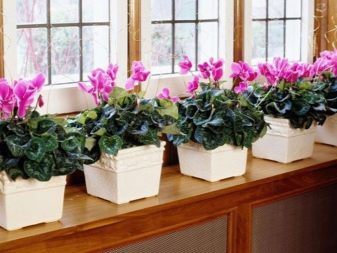
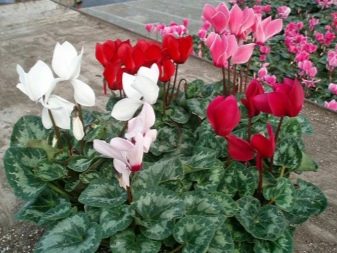
The root system consists of a bulb in the form of an elongated ball, on the surface of which roots grow. The maximum diameter of the tuber is 11 cm. The serrated leaf plate is shaped like a heart and is located on the petiole. The color of the upper side of the leaf is deep green, and the lower side is purple. The diameter of one flower does not exceed 20 mm and resembles a butterfly. The color palette of the buds ranges from pink to purple and purple.
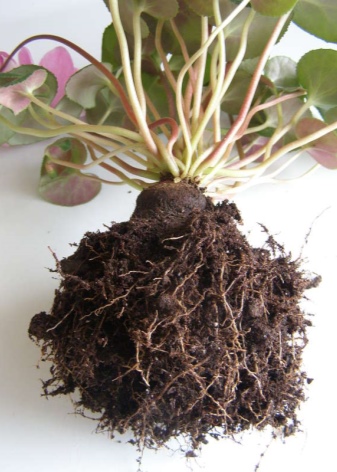
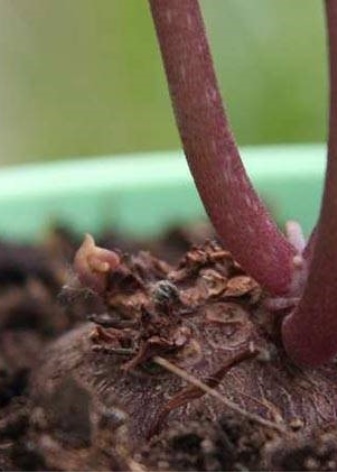
The flowering period lasts over 5 months. Flowers begin to form in mid-spring. A characteristic feature of cyclamen during flowering is the presence of a rich and pleasant aroma. Alpine violet is not only an ornamental plant, but also a medicinal one.
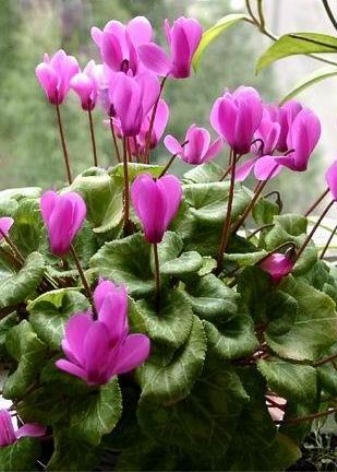
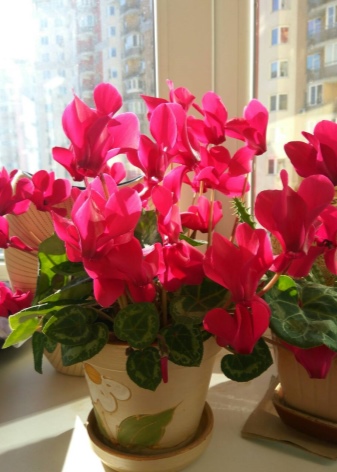
Cyclamen drugs are used to treat the following pathologies:
- gynecological diseases;
- neurological disorders;
- rheumatism;
- inflammation of the upper respiratory tract.
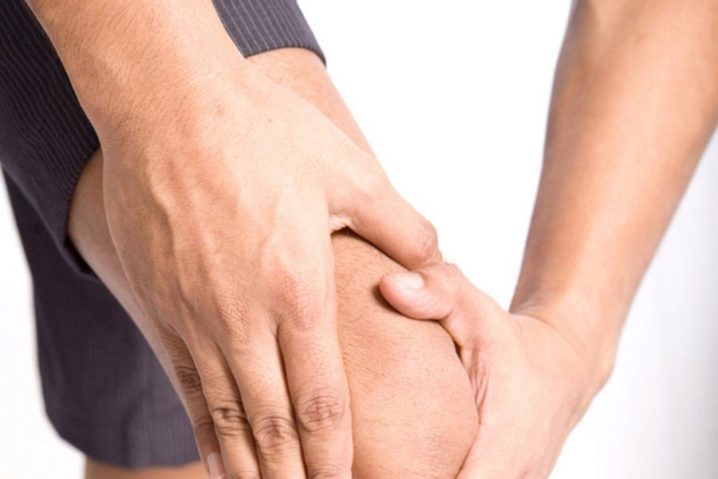
Due to the presence of poisonous substances in the roots, you should consult your doctor before taking medications.
Reproduction
 The plant is propagated by seeds or by dividing the tuber, which is very traumatic for the plant and therefore is rarely used.
The plant is propagated by seeds or by dividing the tuber, which is very traumatic for the plant and therefore is rarely used.
It is better to sow seeds in spring in sterile and steamed soil of sand and peat mixture. Seeds are embedded in grooves, covered with black foil.
Periodically it is necessary to ventilate the seeds and water. The temperature should be at 18-20 degrees. Germination takes place in a month or more.
When shoots appear, the shoots should be freed from the film and transferred to bright diffused light. In this case, the temperature regime should be the same.
When six months have passed, the sprouts should be planted in larger pots. In the first year, the plant will not have a dormant period. Under good conditions, Persian Cyclamen can bloom in 15-18 months. Typically, the time to first bloom is 2 years.
Cyclamen from seeds at home
If you decide to grow this plant from seeds, you should be prepared for the first flowers to appear in 1-2 years, and on the site it may take 3-4 years.
Before sowing, the seeds should be placed in wet gauze or cloth for 24 hours.
If you are taking the seeds from the seed pod and they are still wet, you do not need to soak them.
In 24 hours we will start landing.
It is very convenient to use peat tablets for planting seeds.
Take a pill, place it in a glass of warm water and wait a little while it is soaked in water and swells.
After swelling, take a tablet and squeeze excess moisture out of it so that the seeds do not rot.
Now carefully, with a sharp-sharp knife, cut the tablet into two parts, press the peat with your fingers a little so that it does not fall out of the tablet.
Place one seed in the tablet, making a small indentation and sprinkle it with peat from the tablet so that mold does not develop.
In order for the cyclamen seeds to germinate successfully, they are kept at a temperature of 18 - 20 degrees in complete darkness for 20 days.
Seeds can sprout for 2 months, so be patient and wait.
Peat tablets with seeds, during germination, must be placed in a plastic box and closed to maintain moisture.
Humidity during germination, at least the first 20 days, should be the same all the time, watch this.
All these actions are aimed at creating as natural conditions for cyclamen as possible.
Germination percentage 85% - 100%.
After the shoots appear, they, together with the peat tablet, need to be transplanted into a small pot, the soil can be used, the one that is suitable for violets.
If you do not want to use a peat tablet, you can prepare the seedling soil yourself, for this you will need 90% peat and 10% sand.
Suitable conditions
The flower will please its owner with the flowering only when certain conditions are created
It is important to exclude excessive dryness of the air, to provide a cool temperature and simple maintenance measures. Plants of this family go dormant for several months, but flowering can be repeated up to several times a year.
The soil

Loose soil saturated with organic matter is suitable
The soil for cyclamen can be bought ready-made or made yourself. The best option is a combination of humus, sand, peat and leafy earth. The ingredients must be mixed in equal proportions. The prepared soil should be a breathable coarse peat substrate
It is important to create sufficient aeration of the plant root system.
Illumination
Cyclamens do not like excessive illumination (lighting should be bright, but diffuse). Window sills located on the east or west side are considered ideal conditions for them. Direct sunlight can cause leaves to turn yellow.

Yellowed leaves must be removed by carefully pulling them out from the tuber itself.
The plant is prone to burns. Lack of light can cause poor or no flowering.
Temperature
Temperature conditions play an important role
Particular attention should be paid to the place of purchase of the plant. If it was grown in a greenhouse, then at home it is necessary to repeat the ambient temperature as much as possible.
The accustoming of a flower to new conditions must be carried out in stages. Cyclamen loves coolness. In the cold season, the optimal temperature regime for it should not exceed 10-12 degrees, in the summer - 20 degrees.
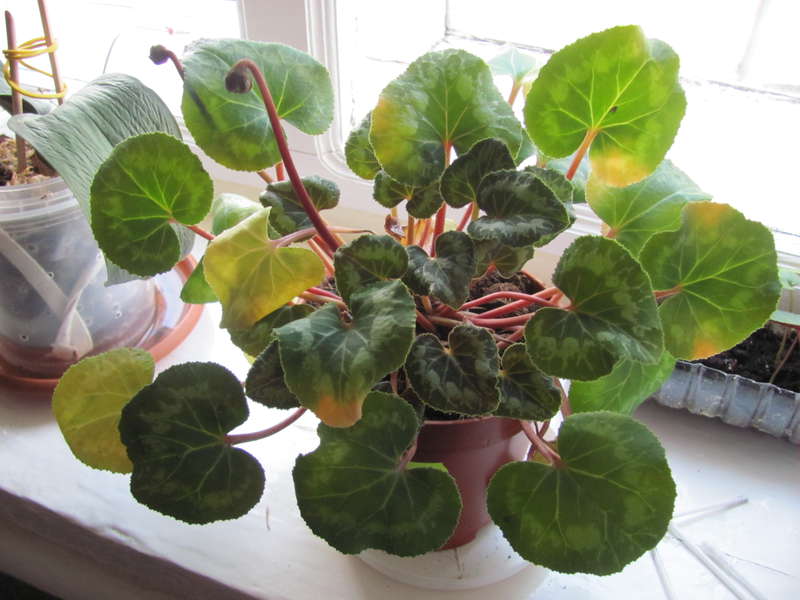
Too high temperature will provoke leaf shedding and lack of flowering
Humidity
For cyclamen, increased moisture levels are required. During the period of plant growth, its leaves must be regularly sprayed. During flowering, such a procedure is prohibited. You can humidify the air using water mist (spray it next to the cyclamen) or a tray with wet pebbles
It is important to exclude the effect of heating sources on the plant.

In winter, cover the batteries with a damp cloth.

